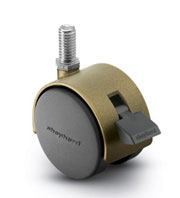
Not all casters feature a rugged design. Because they are used in a wide variety of environments, some of them are designed with an emphasis on aesthetics. Known as decorative casters, they feature an attractive and sleek appearance. If you’re planning to buy a set of decorative casters, however, you’ll need to choose the right type.
Wheel Material
Decorative casters are available in different wheel materials, one of the most popular being neoprene. Also known as polychloroprene, neoprene is a synthetic rubber. It’s strong, durable, flexible and offers excellent resistance to many chemicals. Other common wheel materials include polyurethane, plastic, cast iron and steel.
Wheel Width
Don’t forget to consider the wheel width when choosing decorative casters. Some decorative casters feature wider wheels than others, resulting in a higher load capacity. They distribute their weight across a larger surface area of the floor on which they are used, so they typically have a higher load capacity than casters with narrow wheels.
Finish
The finish is an important element of a decorative caster. Decorative casters are known for their attractive and sleek appearance, but you can find them in different finishes. There are decorative casters with a polished brass finish for a traditional or antique look, and there are decorative casters with a chrome finish for a modern look.
Mounting Type
You should consider the mounting type when choosing decorative casters. While all decorative casters consist of an enclosed wheel, some of them are installed or “mounted” differently than others.
Common mounting types for decorative casters include the following:
- Stem: The casters feature a rod that fits into a hole at the bottom of the furniture or object on which they are used.
- Plate: The casters have a flat square- or rectangular-shaped plate that screws onto the base of the furniture or object on which they are used.
- Threaded: The casters have a threaded rod that’s screwed into a threaded hole on the furniture or object on which they are used. Threaded casters are similar to stem casters, but they have a threaded rod rather than a smooth rod.
Brakes
Brakes are a common feature of decorative casters. When engaged, brakes will immobilize the wheels so that they aren’t able to roll. If you choose decorative casters without brakes, they may roll away unintentionally. A chair or table, for example, may roll away, resulting in damage. You can accidents such as this from happening by choosing decorative casters with brakes.
1
1
1
